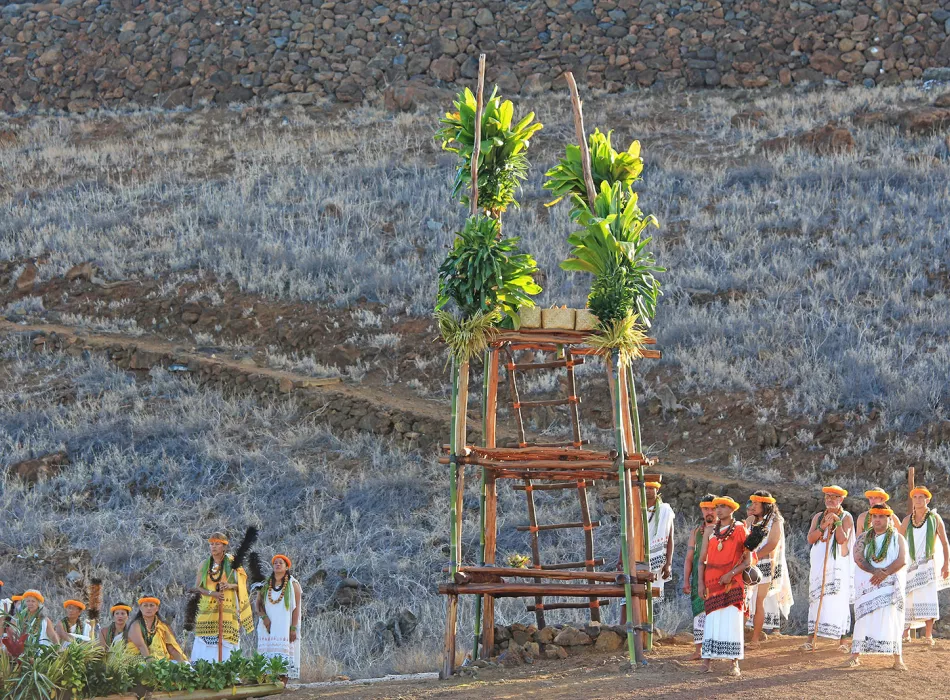
 History
History
A Brief History of the Hawaiian Islands
1,500 years ago: Polynesians arrive in Hawaiʻi after navigating the ocean using only the stars to guide them.
1778: Captain James Cook lands at Waimea Bay on the island of Kauaʻi, becoming the first European to make contact with the Hawaiian Islands. Cook names the archipelago the “Sandwich Islands” after the Earl of Sandwich. A year later, Cook is killed at Kealakekua Bay on the island of Hawaiʻi.
1790: The Battle of Kepaniwai was fought between forces from the island of Hawaiʻi and Maui.
1795: Battle of Nuʻuanu takes place on the southern shores of Oʻahu. It was a key battle in Kamehameha's campaign to unite the islands.
1795-1874: The Kamehameha dynasty reigns over Hawaiʻi.
1810: Kamehameha I unites the Hawaiian Islands.
1819: Liholiho, son of Kamehameha, defies the tradition of men and women eating separately during a feast, which leads to the abolishment of the kapu (taboo) system.
1820: The first missionaries arrive in Hawaiʻi.
1820-1845: Lahaina was the capital of the Hawaiian Kingdom
1835: The first sugar plantation opens on Kauaʻi. The Hawaiian Islands garner recognition for their prime agricultural land. Agriculture becomes a dominant economic force.
Sugar Plantations
A Brief History (Continued)
1830s-1848: The Great Mahele Kamehameha III sought to keep the land in Hawaiian hands by adopting a western allodial system with a new system that would divide the land into thirds – one-third to the Hawaiian crown lands, one-third to the chiefs, and one-third to the people. In the end, the people received less than 1% as the law required land claims to be filed within two years under the Kuleana Act and many Hawaiians made no claim. This was largely because ownership of land was not a common concept.
1845: Honolulu becomes the capital of the Hawaiian Kingdom
1850s: With Hawaiʻi’s plantation production on the rise, a need for more labor is realized. The first workers are recruited from China. Workers also make their way to the islands from Japan, Korea, the Philippines and Portugal.
1874: William Charles Lunalilo dies leaving no heirs. The Kamehameha dynasty comes to an end. David Kalākaua is elected as Lunalilo’s successor.
1878: Lydia Kamakaʻeha (later Queen Liliʻuokalani) pens "Aloha 'Oe"
1881: King Kalākaua becomes the first monarch in history to circumnavigate the globe.
1882: ʻIolani Palace, the official residence of the Hawaiian monarchs, is completed. The Palace was ahead of its time outfitted with the most up-to-date amenities, before even the White House and Buckingham Palace, including the first electric lights in Hawaiʻi, indoor plumbing and even a telephone.
History around Honolulu
History (Continued)
1889: Joseph Kekuku from Lāʻie, Oʻahu invents the steel guitar. He later moves to the US Mainland to share his music with the rest of the world. Steel guitar becomes incredibly popular with country music and is still heard today.
1891: King David Kalākaua dies and Queen Liliʻuokalani takes the throne.
1893: The overthrow of the Kingdom of Hawaiʻi begins. Queen Liliʻuokalani is placed under house arrest at ʻIolani Palace in Honolulu.
1898: Hawaiʻi is annexed by the United States through the Newlands Resolution.
1900: The Organic Act establishes the Territory of Hawaiʻi.
1901: The first Waikīkī hotel, The Moana Hotel, opens on March 11. The resort is affectionately named “The First Lady of Waikīkī.”
1917: Queen Liliʻuokalani, the last sovereign of the Hawaiian Kingdom, passes away.
1941: On December 7, 1941, the Japanese launch a surprise attack on Pearl Harbor on Oʻahu during World War II.
1945: On September 2, 1945, Japan signs its unconditional surrender on the USS Battleship Missouri. Although the signing didn't take place in Pearl Harbor, the ship is now part of museum and memorial complex at Pearl Harbor, offering activities and tours to visitors from all over the world
World War II History
Recent History
1966: Don Ho releases his signature song, "Tiny Bubbles." The album makes the Billboard Top 20 and stays in the charts for nearly a year. His music and style become synonymous with Hawaiian leisure.
1978: The Hawaiʻi State Constitutional Convention makes Hawaiian the state's official language (the only state in the U.S. with a non-English official language).
1980: Hawaiʻi becomes the home of the NFL Pro Bowl when the AFC-NFC all star game lands in Oʻahu's Aloha Stadium. The Pro Bowl is hosted in Hawaiʻi for 26 years, until 2017 when it moved to Orlando, FL.
1990: Kīlauea, one of the world's most active volcanoes located on the island of Hawaiʻi, erupts sending lava through the town of Kalapana. While it destroyed the town, it also created a new coastline that extends nearly 1,000 feet farther into the Pacific Ocean.
2009: Senator Barack Obama is inaugurated as the 44th President of the United States. Obama, who was the first African American to have served as president, was born in Honolulu, Hawaiʻi.
2011: Hawaiʻi hosts the Asia-Pacific Economic Cooperation.
2013: The Mālama Honua Worldwide Voyage begins. The four-year voyage covered over 60,000 nautical miles, 100 ports, and 27 nations, including 12 of UNESCO’s Marine World Heritage sites. The mission was to take Hawaiʻi's iconic cultural sailing canoe Hōkūleʻa around the world and her sister canoe Hikianalia around the Pacific and the Hawaiian Islands, to grow a global movement toward a more sustainable world. The voyage sought to engage all – practicing how to live sustainably, while sharing Polynesian culture, learning from the past and from each other.
2017: Mālama Honua Worldwide Voyage completes its journey.
More Ways to Experience Hawaiian History

Help Save The ʻŌhiʻa Trees
King Kamehameha I

Experience Hawaiian History
Please note: We apologize for any inconvenience, but our preferred business listings below are in English only.






